
|
An Historic End Like the Southwestern a few years earlier, the LSE now found itself in the position of needing to shed branches that were losing money. Unfortunately, one such branch was the historic Sandusky, Milan & Norwalk. Extensive track work was required that represented a serious financial strain by itself, but the trestle situation was even worse. The decision to route the SM&N over hilly terrain that necessitated multiple trestles may have been expedient for a few back in 1893, but by 1927 the chickens had come home to roost. At least three trestles, including the exceptionally long one over Rattlesnake Creek, were in dire need of replacement. Purportedly, an LSE official who lived in Norwalk and commuted to the office in Sandusky had a severe distrust of the dilapidated trestles. He was certain that it was only a matter of time before one of them would collapse under the weight of a heavy interurban car. Supposedly his fear was so strong that he refused to travel by that route, preferring the much longer commute via Ceylon Junction. The total cost of properly rebuilding the line was estimated at $75,000. Furthermore, the LSE would be assessed for an underpass project at Avery if rail service were continued. The low patronage of the line could never justify such a large expenditure, even if the funds had been available. A request to replace rail service with buses was filed on January 17, 1927, and permission was granted at a hearing held July 8. The Norwalk Bus Company made another attempt to wrest the route away from the LSE, but only one bus certificate was on offer and the LSE, as the current operator, was given priority. The last day for the electric cars was scheduled for March 31, 1928, but a late winter storm stopped them two days earlier. Traffic resumed April 6 with a single bus making the trip between cities in forty-five minutes. Ohio's pioneering interurban, once the longest in the country, came to an end thirty-five years after People's Electric Railway car 4 ushered in a new age by making a slow trip from Sandusky to Norwalk. The Norwalk Bus Company eventually got what it had wanted anyway. Continuing changes led the LSE to pull their single bus from the Sandusky-Norwalk route and sell the certificate to Norwalk Bus Co. on October 31, 1931. Mainline passenger schedules changed again in November 1927 with the creation of "express" cars. Limiteds between Cleveland and Detroit used the Sandusky division, while the alternate hour express cars used the Norwalk division on their way to Toledo. Cleveland- Toledo locals were eliminated, so the express cars made some local stops along the way. By 1930, however, nearly all Cleveland-Toledo cars were run through Sandusky. Fight for Freight Interurban freight was one source of revenue that was actually on the rise in the late 1920's, but faced increasingly vigorous competition from trucks. To counter this, the LSE and its connecting lines formed the Electric Railways Freight Company in November 1928 (which included a truck subsidiary of its own). By 1929 freight accounted for 48% of all receipts. Norwalk residents didn't always appreciate the trains of freight trailers rolling down Main Street in the middle of the night, but they were keeping the LSE in business. John Ernsthausen, however, wanted that business for his own growing company. In 1927, Norwalk Truck Line asked to increase the size of its fleet beyond what was allowed by its original motor carriers certificate. The LSE objected, but the Public Utilities Commission allowed it. Another setback came in 1932, when Norwalk Truck Line applied to operate between Bellevue and Elyria. The LSE maintained that it already adequately serviced the route, but the truck line had allies. Ernsthausen pointed out that although the LSE passed through Berlinville, it had no freight facilities there, only at nearby Berlin Heights. A Toledo wholesaler testified that his business would benefit from direct motor freight service to Berlinville. It was a rather absurd claim, as the population of the rural hamlet was only 100 people, but Norwalk Truck Line won the certificate at least partially on this argument. That same year the LSE found itself on the wrong end of the motor carrier certificate system when the PUC ruled that the railway needed a certificate to operate its successful Bonner Railwagons. The LSE appealed to the courts but lost. The Dominoes Fall As bad as truck competition was, the loss of connections to other railways inflicted far worse wounds on freight service and thus the LSE as a whole. The entire interurban system was falling like dominoes. The Southwestern, out of Norwalk and in receivership since 1923, went out of business in January 1931. In July, the Northern Ohio Traction & Light quit hauling freight, which made the Electric Railway Freight company obsolete. In January 1932, the Western Ohio and its connection to the LSE went out of business. And in October, the last link to Detroit was severed when the Eastern Michigan-Toledo railway shut down. Traffic on the LSE as a whole fell to its nadir, and the southern division through Norwalk was the slowest of all. Effective July 20, 1931, all Cleveland-Toledo cars (only six were scheduled each way daily) were dispatched via Sandusky. Cars on the southern division essentially became shuttles, with passengers traveling beyond Ceylon Junction or Fremont required to change cars at those points. A revised schedule issued on June 18, 1934, was a slight improvement. A morning commuter express originated in Fremont and ran through to Cleveland, with a second running from Norwalk to Ceylon Junction. The other seven scheduled cars were Fremont-Ceylon shuttles only. On Saturdays a single express car ran from Cleveland to Fremont via Norwalk in the morning. At the peak of the second interurban boom in 1913, Norwalk had witnessed 125 cars a day, from three lines and all directions. Norwalk passengers could board an LSE limited, usually an elegant Niles car, that would join its northern division counterparts and together rush to Cleveland, Toledo, or Detroit as a two or three car train. By 1934 only the LSE was left, multi-car trains were a thing of the past, and no limiteds came to town. Less than 20 cars visited the Maple City each day, and although they were still Niles cars they were visibly aging and had been demoted to yeoman's work. The bus fight continued in 1935, with both Buckeye Stages and Central Greyhound Lines petitioning for certificates to compete with the LSE Norwalk division. In March 1936, the PUC ruled that there was no public necessity for competing service, and that the LSE was "adequate, efficient, and sufficient." The 1937 timetable shows nine expresses, but only one ran through to Cleveland or Toledo. Although called expresses, the others were essentially shuttles, requiring a car change at Fremont or Ceylon. Further fragmentation occurred on November 17, 1937, when the LSE was severed at Bellevue due to construction of a subway under the Nickel Plate railroad. The Ceylon Junction shuttle through Norwalk then ran only as far as Bellevue where a taxi transferred riders across the construction site. In these final days, shuttle service was operated with the sturdy, but well worn Barney & Smith cars that had first come to Norwalk in the spring of 1901 wearing TF&N yellow. Any hope that the railway could weather the depression had been dashed by the freight handlers' strike in May 1937, and preparations for bus replacement had begun. On February 2, 1938, the Norwalk division was cut down to a single car per day as Lake Shore Coach Co. buses were phased in. The end came to Norwalk on May 13, 1938. The somber distinction of being the last car out fell to LSE 18, the ex-Toledo, Fremont & Norwalk car once known as The Yellow Flyer for the speed records it set. It made a final stop at the Norwalk station, across the street from the Case Block where the first station had been located nearly forty years earlier. Birney 115 was hitched to the rear of the heavy interurban to be towed to the Sandusky shops. After pausing to pose for a photo to commemorate the sad occasion, the cars rolled away for the last time. Electric interurbans had meant a great deal to Norwalk in the years surrounding the turn of the century. Unfortunately, fate did not see fit to bestow the LSE, nor the city, with enduring fortune or greatness. Norwalk was most sentimental about one particular aspect of the LSE, which can best be expressed by reprinting part of what a local newspaper wrote the following day: While Norwalk's regret at the passing of the big Lake Shore Electric interurban cars may be tinged with relief at the prospect of no more strings of freight cars rumbling through the principle [sic] street all night long, yet news today that the "dinkey" no longer would be operated here brought genuine and unrestrained grief, for the "dinkey" is a 30-year institution, spelled with a Capital D. Technically, the last electric cars through Norwalk were freight motor 31 and line car 455, which helped dismantle the railway throughout 1938. Rails, overhead wire, and bridges were all hauled away for scrap. Many of the car bodies were sold to the public to be repurposed in myriad ways. Birney 115 was purchased in September 1938 by R.M. Fixler of Vermilion, but to what use it was put and what fate it ultimately met are uncertain. Eight Decades Later Much of the LSE has faded into the surrounding landscape or under the ever-expanding residential neighborhoods over the ensuing decades, but many notable sites and artifacts can still be found in and around Norwalk. Following State Route 61 west toward Norwalk, the LSE right-of-way is visible in many places along the side of the road. The present line of electrical poles still mark it clearly. At the intersection with Wells Road, the new highway veers to the right, while the pole line continues to follow the LSE along Gibbs Road. This was the location of the gruesome 1904 wreck. The LSE bridge was removed in 1938, but the stone abutments remain, although on private property and obscured most of the year. Further south on Gibbs Road, near State Route 601, a large concrete arch culvert can be seen from the road, especially in the fall and winter. Most traces of the Sandusky, Milan & Norwalk have disappeared, but in some places along Old State Road the trained eye can spot where the terrain was filled to create the roadbed. The long trestle over Rattlesnake creek is long gone, and the paved road that gently descends into the valley bears little resemblance to period photos of the SM&N. Alling's Junction, where the LSE tracks joined the SM&N on East Main Street, was located near present-day Oakwood Drive. The bridge over the old Wheeling & Lake Erie Railroad tracks at the intersection of East Main and Schauss Ave. is easy to miss. It was there that the last piece of track was quickly laid on August 9, 1893, so that Thomas Wood and his fellow SM&N officials could complete their historic first trip to town. Downtown Norwalk is filled with well-preserved historic buildings, and once familiar with the old photos it is easy to walk down Main Street and imagine you're part of those images captured a century ago. The storefronts of the Case Block and the Newman Block, where the LSE and CSW waiting rooms were located, are still there on opposite sides of Hester Street. The LSE freight house on Whittlesey, however, is gone. After the end of the LSE, it saw use as a gas station, newspaper distribution center, and an insurance agent's office before it was razed in May or June of 1958 to make way for new construction. The magnificent Glass Block, once Norwalk's tallest building, does remain, but in a drastically altered form that most would not recognize. It was reduced from five stories to only two in the early 1950's, and an exterior facade was applied, leaving it a pale shadow of its former glory. A few doors away, the former St. Charles Hotel, which acted as a hospital to those injured in the Wells Corners accident, is now the popular Berry's Restaurant. The interior walls are adorned with photos of historic Norwalk, and the adjoining bar is named The Dinkey, in honor of Fred Gassman's city car. Leaving downtown, West Main Street is flanked by many historic homes that have stood watch as the TF&N was built, the LSE came and went, and automobiles became supreme. West Main's descent to the Huron River has been bypassed in the name of that automotive supremacy, but the old road still exists, as do the concrete abutments of the bridge built for the TF&N in early 1901. As the old road begins to climb out of the valley, and dead ends before reaching the new highway, the interurban right-of-way can be seen on the right side. For many years, one man's farm on State Route 18, a few miles east of Norwalk, was a required stop for anyone interested in the LSE. Paul Eckler had a life-long passion for the LSE. At the age of 16 he participated in the last fan trip over the LSE on April 3, 1938, chartered by the National Railway Historical Society. Paul became a respected high school teacher, a widely admired man with many friends and unlimited local connections. In 1965 he acquired two LSE cars, which he moved to his farm and repainted in their original colors and lettering. Car 149 had been used for storage at an airport in Lorain, while car 151 had been converted to a barbershop in Berlin Heights. There is no shortage of photos showing visitors standing next to, or in the doorway of, Paul's beloved interurban cars, and more than a few people were introduced to the history of the LSE thanks to him. Sadly, Paul Eckler passed away in 1993, and his cars were sold off shortly after. They were separated and moved around to various locations, but today the cars have been reunited and are awaiting restoration at the Northern Ohio Railway Museum near Medina. The grandiose predictions and lofty dreams set for Norwalk at the turn of the 20th century were never realized. Perhaps because of that, Norwalk survives today as a lively but peaceful small town that its residents, mindful of their history, are proud to call home. The Lake Shore Electric is a significant part of that history, and while all the depth and details may not be widely known, it is far from forgotten in Norwalk. |

revised its schedules hoping to adapt to changing demands. (Plain Dealer) |
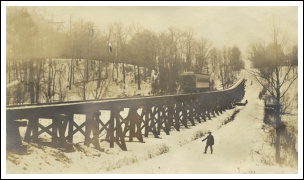
of replacement by 1927, but the cost was prohibitive. (Dennis Lamont) |
|

service was granted in July 1927. (Erie County Reporter) |
|

A single bus made a round trip every two hours. (Dennis Lamont) |
|

became an increasingly aggressive competitor for freight in the late 20's through the 30's. (Drew Penfield) |
|

Freight Co. in 1928 to help counter the truck line competition. (Dennis Lamont) |
|

interurbans. But they dominate this photo taken at Main and Whittlesey in 1930. (Kevin A. Powers) |
|
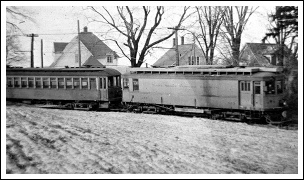
1934 and is being towed by a line car near Allings Junction. (Dennis Lamont) |
|

Street at Allings Junction. Switch to the LSE main line is visible behind the car. (Firelands Historical Society) |
|

the PUC ruled against bus line competition. (Plain Dealer) |
|

Norwalk still got shuttle cars only, no limiteds. (Drew Penfield) |
|

approaches to meet on West Main Street on August 9, 1937. (James P. Shuman photo) |
|
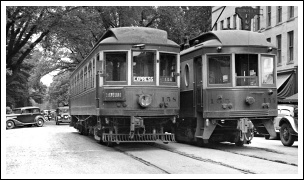
previous photo was taken. (James P. Shuman photo) |
|

schedule was reduced to a single car per day. (Plain Dealer) |
|
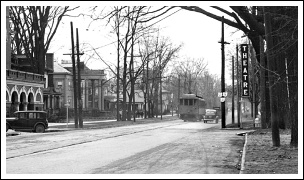
duty on March 8, 1938, rolls into town on West Main Street. (Ralph A. Perkin photo) |
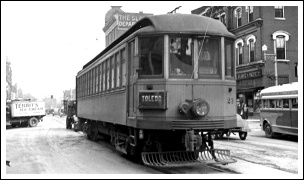
Coach Co. bus rolls by on its way to Ceylon Jct. (Ralph A. Perkin photo) |

towed the city car to Sandusky and interurbans disappeared from Norwalk forever. (Firelands Historical Society) |

Birney car 116. Fred had worked the Norwalk city car for thirty two years. (Firelands Historical Society) |

State Route 61 in this photo from 1978. (Dennis Lamont photo) |

(Dennis Lamont photo) |

remain, although on private property and usually obscured. (Dennis Lamont photo) |

from Gibbs Road near State Route 601. (Fred Schneider photo) |

Sandusky, Milan & Norwalk trestle over Rattlensnake Creek. (Dennis Lamont photo) |

entering Norwalk still exists along Old State Road. (Dennis Lamont photo) |

waiting room, while the company offices were on the second floor. (Christopher Riley photo) |

make way for new construction in 1958. (Sandusky Register) |

floors and remodeled in the early 1950's. (Drew Penfield photo) |

decorated with many photos and artifacts of Norwalk history. (Christopher Riley photo) |

the Huron River. LSE right of way is at left. (Dennis Lamont) |

Street in 2011. The bridge was built for the TF&N in 1901. (Drew Penfield photo) |

liked and respected by all who knew him. (Dennis Lamont) |

original colors, from 1965 to 1993. Both cars still survive. (Jim Spangler photo) |
|
|
|